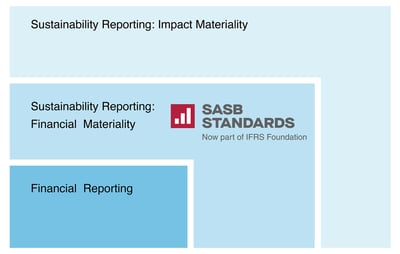The Sustainability Accounting Standards Board (SASB) was founded in 2011 as a not-for-profit, independent standards-setting organization. SASB’s mission was to establish and maintain industry-specific standards. The goal of these standards is to assist companies in disclosing financial material, and decision-useful sustainability information to investors.
The SASB Standards identify the subset of ESG issues most relevant to financial performance and enterprise value for 77 industries. The Standards were developed using a rigorous and transparent standard-setting process that included:
- Evidence-based research;
- Broad and balanced participation from companies, investors, and subject-matter experts; and
- Oversight and approval from the independent SASB Standards Board.
Global investors recognize SASB Standards as essential requirements for companies seeking to make consistent and comparable sustainability disclosures.
Latest Updates
In June 2021, SASB and the International Integrated Reporting Council announced their merger to form the Value Reporting Foundation (VRF). In November 2021, the IFRS Foundation announced it would integrate the VRF and Climate Disclosure Standards Board. This includes its newly formed International Sustainability Standards Board by June 2022. As of August 2022, the International Sustainability Standards Board (ISSB) of the IFRS Foundation assumed responsibility for the SASB Standards.
The ISSB has committed to building on the industry-based SASB Standards and leveraging SASB’s industry-based approach to standards development. The ISSB encourages preparers and investors to continue to provide full support for and to use the SASB Standards until IFRS Sustainability Disclosure Standards replace SASB Standards.
Who uses SASB?
The ISSB aims to build on the industry-based SASB Standards and embedding SASB’s industry-based approach to standards development.
Companies worldwide use SASB standards for their annual reports, financial filings, company websites, sustainability reports, and more.
SASB Standards play an important role in the ISSB’s Climate-related Disclosures Exposure Draft and General Requirements for Disclosure of Sustainability-related Financial Information Exposure Draft. The use of SASB Standards, therefore, is good preparation for the implementation of the IFRS Sustainability Disclosure Standards when they are available for use.
The ISSB also has committed to enhancing the international applicability of the SASB Standards before the effective date of the General Requirements Exposure Draft.
SASB Standards can provide a baseline of investor-focused sustainability disclosure and to implement the principles-based framework recommended by the TCFD. This is also incorporated into the ISSB’s Climate Exposure Draft. Similarly, SASB Standards enable robust implementation of the Integrated Reporting Framework, providing the comparability sought by investors.
SASB Standards & Other ESG Frameworks
It is useful to understand the difference between sustainability frameworks and sustainability standards.
Frameworks are looking to provide principles and guidance for how information is structured and presented in reports.
Standards are about ensuring granularity, reliability, and comparability of topics for stakeholders, investors, and corporates. Discover the latest news on the key ESG Reporting Frameworks and Standards put together by our team of industry professionals.
SASB Standards recognize the sustainability information that is financially material to understanding how a business creates value. That information, also known as ESG information, is used by those who aim to make better financial decisions.

Impact materiality, which is more comprehensive than SASB Standards, captures the major effects that an organization has on the economy, environment, and people. Enterprise value does not cover these effects. Users with a range of goals are interested in learning about an organization’s positive and negative effects on sustainable development.
According to SASB Standards, financial materiality refers to sustainability elements that are important for the short-, medium-, and long-term value of a company.
Narrower than SASB Standards. Financial reporting includes estimates of cash flows as well as assumptions that are already reflected in the financial statements. Those whose main goal is to enhance business decisions are the main users.
The world of sustainability reporting changes constantly. As new terminology, guidelines, tools, and mandates launch each year, it is helpful to have services and support from a trusted advisor. Cority’s Sustainability Cloud solution, along with our team of ESG and sustainability experts, supports organizations to advance their sustainability strategies across their value chain and beyond. Interested in learning more? Connect with our experts today.











